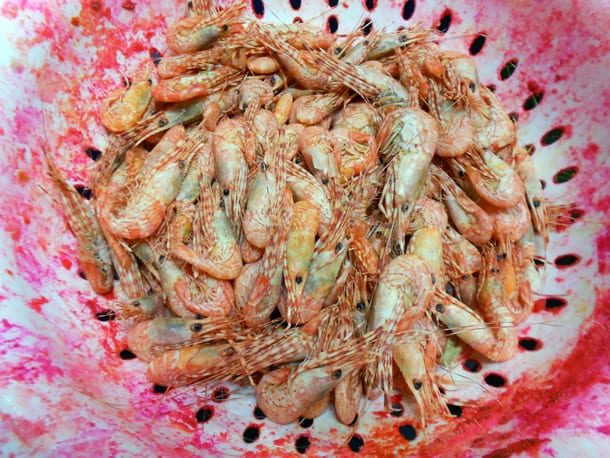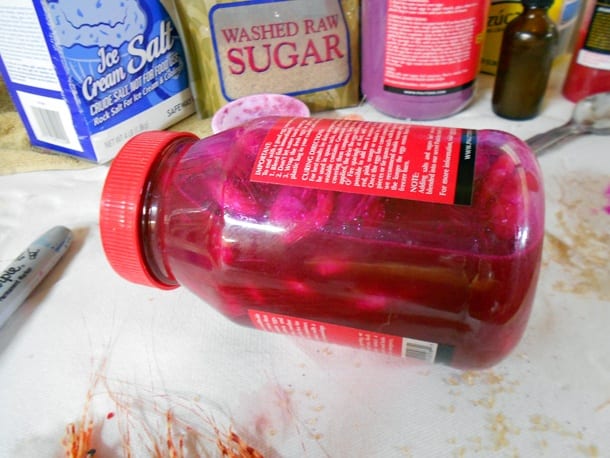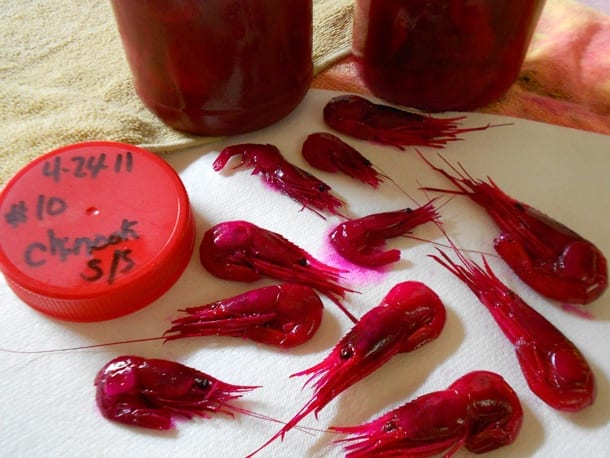Spawn
Curing Prawns & Coon Shrimp For Spring & Fall Salmon
By Duane Inglin | 05/04/2014
Do you use coon shrimp or prawn for springers? That’s a question I’m often asked. In the past we’ve explained how to cure coon-shrimp for steelhead. On the other hand, anglers are craving a recipe’s for curing coon-shrimp or Arctic prawn for salmon. More specifically, “spring Chinook”.
Curing shrimp and prawns for steelhead is similar to what I’d recommend for springers. Many anglers have read our previous articles, watched our video’s and have been to my seminars and fortunately the recipe for salmon and steelhead doesn’t differ much. In fact, many anglers have had great success on the Columbia and tributaries, fishing the well known steelhead recipe for salmon. Ironically, when targeting spring Chinook, the biggest complaint I hear is that fishermen can’t keep sockeye from biting the coon shrimp. What a terrible problem to have!
Below is a link to a previous blog, on how to cure coon shrimp for steelhead.
https://www.pautzke.com/fireblog_read.php?read=17
Creating fantastic coon shrimp or prawns to fish for springers is simple. I use the exact recipe with a few minor adjustments. Below are the basic ingredients for a 1 quart jar.
1 bottle Pautzke’s red Nectar
¼ cup Borx O Fire (red)
¼ cup non-iodized sea salt
¼ cup rock salt
¼ cup refined white sugar
¼ cup washed “raw sugar” it’s extremely sweet
1 table-spoon Pautzke krill powder (Fire Power)
10 to 15 drops of pure anise
The difference between curing for steelhead and springers is sodium sulfite. You can find sodium sulfite in most retail outlets where other bait cure products are sold. However, I never add more than (1/2 to 1 Tablespoon) of sodium sulfite. Too much will cause the shrimp to become extremely brittle and you wont be happy with how they fish.
As far as tweeking this recipe, there is one thing about spring Chinook and salmon that you need to know. They can have a sweet tooth. One day they want a sweet bait and the next day they want a salty or garlicy bait. I rely on my basic recipe because it preserves the shrimp and adds great color and scent. They also fish extremely well because they are durable. I then can make adjustments to the basic recipe to create different baits.
Examples:
*I may remove the ¼ cup of sea salt from the recipe. This makes the bait extremely sweet, as there is twice as much sugar as salt. This may make the shrimp a bit soft, however. It depends on the quality of the shrimp before I cure them.
*I sometimes will leave out the refined sugar and create a bait that has more salt in the cure than sugar. This obviously creates a saltier shrimp.
*Some jars will get one tablespoon of minced natural garlic (purchase at the grocery store). This adds a potent amount of garlic to the prawn or shrimp. I do not use manufactured scent-oils. I want the natural garlic to absorb into the shrimp rather than having oil floating on top of the mixture.
Preperation
This recipe is flexible. It’s important to care for your coon shrimp or arctic prawn before and after they are cured.
If you purchase more then you plan to cure, no worries. Simply place them into a container and cover them in distiled water. Snap the lid on and place your shrimp in the feezer. Remember to leave room for expasion. Shrimp or prawn will keep for a couple years frozen like this. They will not freezer burn or decay.
To thaw, I dump the container into a colander over a small garbage can. As the ice melts the water drips away. Keep in mind, you don’t want the shrimp bathing in water for a couple days as they thaw. This softens them.
Once thawed, they are ready to be sorted (by size) and cured. When curing coon shrimp I usually put them into three different sizes. However, Arctic prawn are similar in size. Sorting helps locate any soft or damaged shrimp. You can’t cure bad or broken shrimp.
Once sorted, they are ready for the cure.
I mix the contents into the jar and add the shrimp, but need to top off the jar with additional liquid. I have a few choices: distilled water, more red Nectar or even red Fire Brine. All are acceptable and work.
When it comes to jars I try to not use glass anymore and instead use empty BorX O Fire plastic jars and lids. Try to keep the thin Styrofoam gasket intact. This is the perfect size jar and with the gasket, the contents won’t leak. It’s also safe to take in the boat for the day and not have to worry about breakage, like glass.
I always make sure I write on the lid, the exact recipe I put into the jar. If I have a jar of shrimp that fishes really well, but can’t remember what I put in the cure it does me no good for the future. For example, I know it’s my basic recipe and my shorthand indicates to me Red BorX O Fire with Nectar, plus anise and sodium sulfite. Also, put the date on the jar (more on that in a bit).
With all the contents and shrimp in the jar I can now lay the jar on its side. It should have just a small amount of room in the jar. This is important so I have room to continue to mix the contents.
If I stand the jar on end, all the granulated contents will settle to the bottom and compact. This makes it difficult to mix them up. For the first few weeks I store these jars in my bait fridge on their side. The side of the jar is much wider and doesn’t allow all the contents to compact so tightly.
With the newly cured coon shrimp or prawns stored on the side, I take a few minutes a couple times a day and simply turn the jars end-over-end. This will mix the contents and the shrimp. The sugars and salts are breaking down and absorbing into the shrimp. The mixing is important so all the shrimp will cure equally and all the contents of the mix do not simply lie in the bottom of the jar. The mixing is something to do daily for a few weeks. You’ll notice the salts and sugars begin to disappear.
Please keep in mind this is not an overnight cure. This recipe (or pickling) takes three weeks. Then the shrimp are ready to fish. For those who have taken the time to cure their coon-shrimp or Arctic prawn with this recipe, the results say it all.
There are a number of other ways to cure coon shrimp and prawns. I continue to do it with my recipe, because it works. It’s also proven its value in longevity. You can use a number of sprinkle-cures to get the shrimp cured. If you are a guide or fish a lot, that may work. However, this recipe yields dependable, long lasting, quality cure shrimp that smell good, look great and are worth the extra effort.
Here are some coon shrimp and prawns I cured in April of 2011. That’s more than three years ago. I’ll be fishing these this week for springers. They are still firm, not brittle, flexible, have great color, scent and will fish fantastic. Isn’t that exactly what we want in a good bait?
Editor’s Note: Duane Ingin is the co-host of Seattle’s Northwest Wild Country Radio. He has his own Bait Lab, in the garage.














